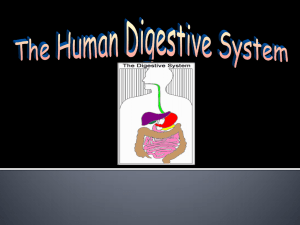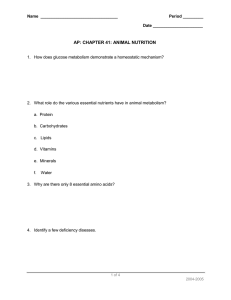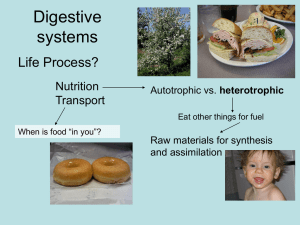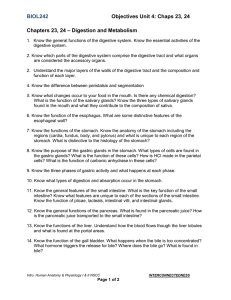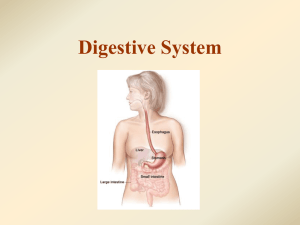What should I study for the test?
advertisement
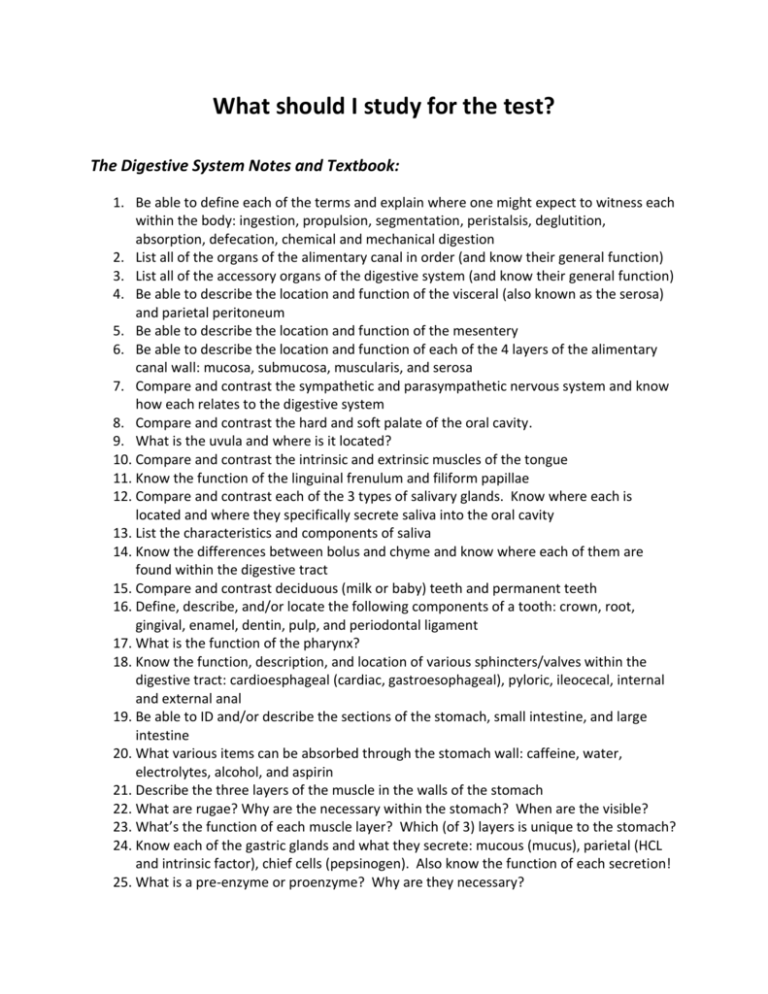
What should I study for the test? The Digestive System Notes and Textbook: 1. Be able to define each of the terms and explain where one might expect to witness each within the body: ingestion, propulsion, segmentation, peristalsis, deglutition, absorption, defecation, chemical and mechanical digestion 2. List all of the organs of the alimentary canal in order (and know their general function) 3. List all of the accessory organs of the digestive system (and know their general function) 4. Be able to describe the location and function of the visceral (also known as the serosa) and parietal peritoneum 5. Be able to describe the location and function of the mesentery 6. Be able to describe the location and function of each of the 4 layers of the alimentary canal wall: mucosa, submucosa, muscularis, and serosa 7. Compare and contrast the sympathetic and parasympathetic nervous system and know how each relates to the digestive system 8. Compare and contrast the hard and soft palate of the oral cavity. 9. What is the uvula and where is it located? 10. Compare and contrast the intrinsic and extrinsic muscles of the tongue 11. Know the function of the linguinal frenulum and filiform papillae 12. Compare and contrast each of the 3 types of salivary glands. Know where each is located and where they specifically secrete saliva into the oral cavity 13. List the characteristics and components of saliva 14. Know the differences between bolus and chyme and know where each of them are found within the digestive tract 15. Compare and contrast deciduous (milk or baby) teeth and permanent teeth 16. Define, describe, and/or locate the following components of a tooth: crown, root, gingival, enamel, dentin, pulp, and periodontal ligament 17. What is the function of the pharynx? 18. Know the function, description, and location of various sphincters/valves within the digestive tract: cardioesphageal (cardiac, gastroesophageal), pyloric, ileocecal, internal and external anal 19. Be able to ID and/or describe the sections of the stomach, small intestine, and large intestine 20. What various items can be absorbed through the stomach wall: caffeine, water, electrolytes, alcohol, and aspirin 21. Describe the three layers of the muscle in the walls of the stomach 22. What are rugae? Why are the necessary within the stomach? When are the visible? 23. What’s the function of each muscle layer? Which (of 3) layers is unique to the stomach? 24. Know each of the gastric glands and what they secrete: mucous (mucus), parietal (HCL and intrinsic factor), chief cells (pepsinogen). Also know the function of each secretion! 25. What is a pre-enzyme or proenzyme? Why are they necessary? 26. What is the function of the hormone Gastrin? Where is gastrin produced? 27. What are the three phases of digestion? Specifically, what is the stomach doing during each phase? 28. What are the functions of each secretin and cholecystokinin and where are they produced? 29. What three things (components of the brush border) are responsible for increasing surface area within the small intestine? 30. What is a lacteal and what is its function? 31. Where are the greater and lesser omentum located and what are their functions? 32. What is the general digestive function of the liver? Of the gall bladder? 33. Where do bile and pancreatic juices enter the small intestine? 34. Bile is not an enzyme! What is the function of bile? 35. Haustra are located in the large intestine. What are haustra? 36. What are the components of feces? 37. What enzymes are responsible for the digestion of each carbohydrates, lipids, nucleic acids, and proteins? 38. Where does the digestion of each specific macromolecule begin and where specifically does it end? (e.g. salivary amylase in the mouth begins the digestion of the carbohydrates. Carbohydrates are further digested in the small intestine) 39. What are the monomers of each carbohydrates, lipids, nucleic acids, and proteins? 40. What enzymes are found in pancreatic juice? 41. What is the function of bicarbonates in the pancreatic juice? 42. What is the function of cellulose in the human diet? 43. Be able to identify all of the organs of the alimentary canal and accessory organs within the dissected cat 44. Be able to ID all of the enzymes we discussed in class. Know where they are produced and secreted and well as what macromolecule they target and what they specifically break that macromolecule into. Also know which enzymes have proenzymes. This study guide includes most, but not all of the information that you will need to know for the test. Please refer to your study guide, textbook, and notes in order to completely prepare for this test!

